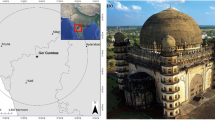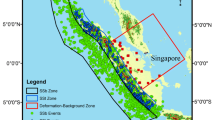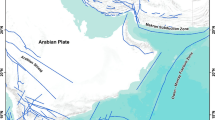Abstract
The present study attempts to understand and assess the seismic hazard of Mumbai using probabilistic seismic hazard analysis (PSHA) with an updated catalogue of earthquake clubbed with recent knowledge on seismotectonics of the region. An updated catalogue of instrumental and pre-instrumental earthquake data within 300 km radius around the city has been compiled from different sources. The PSHA has been computed using two different seismic source models, viz., a fault (linear) and zone model (areal). A hybrid of five suitable ground motion prediction models (GMPM) consisting of widely accepted and latest GMPMs is used to compute the PSHA of Mumbai. The results obtained from different methodologies are integrated with logic tree approach to minimize the epistemic uncertainties in hazard calculation. Probabilistic seismic hazard maps in terms of peak ground accelerations (PGA) at bedrock levels for 2% and 10% probability of exceedance in 50 years are developed for Mumbai. Uniform hazard response spectrum (UHRS) on bedrock at eight different sites within Mumbai for spectral periods of 0.01—2 s is also computed. The low seismic hazard is observed and reasonably compared with the previous PSHA studies done for Mumbai region.







source models (linear and areal sources), estimated maximum magnitude earthquake (maximum observed magnitude and 0.5 units incremented to the maximum observed magnitude) and GMPEs (five GMPEs) used for computation of seismic hazard in the region. Logic tree consists of 20 branches, wherein each branches are assigned equal weightages


Similar content being viewed by others
Data availability
Earthquake catalogue used in this study was compiled using data available online from various agencies such as National Center for Seismology (NCS), India (https://seismo.gov.in/content/seismological-bulletins), United States Geological Survey (USGS) https://earthquake.usgs.gov/earthquakes/search/ & International Seismological Centre (ISC) http://www.isc.ac.uk/iscbulletin/search/catalogue/.
References
Abrahamson NA, Silva WJ (1997) Empirical response spectral attenuation relations for shallow crustal earthquakes. Seismol Res Lett 68(1):94–127
Aki K (1965) Maximum likelihood estimate of b in the formula log N = a-bm and its confidence limits. Bull Earthq Res Inst Univ Tokyo 43:237–239
Algermissen ST, Perkins DM (1976) A probabilistic estimate of maximum acceleration in rock in the contiguous United States. USGS Open File Rep 76:45
Anbazhagan P, Vinod JS, Sitharam TG (2009) Probabilistic seismic hazard analysis for Bangalore. Nat Hazards 48:145–166
Ashish Lindholm C, Parvez IA, Kuhn D (2016) Probabilistic earthquake hazard assessment for peninsular India. J Seismol 20(2):629–653
Atkinson GM, Boore DM (2006) Earthquake ground-motion predictions for eastern North America. Bull Seismol Soc Am 96:2181–2205
Barbour AJ, Pollitz F (2019) Induced seismicity reduces seismic hazard? Geophys Res Lett 46:4170–4173. https://doi.org/10.1029/2019GL081991
Basu S, Nigam NC (1977) Seismic risk analysis of Indian peninsula. In Proceedings of Sixth World Conference on Earthquake Engineering, New Delhi. Vol. I: 782–788
Bhatia SC, Kumar MR, Gupta HK (1999) A probabilistic seismic hazard map of India and adjoining regions. Ann Geofis 42:1153–1166
Bodin P, Malagnini L, Akinci A (2004) Ground motion scaling in the Kachchh basin, India, deduced from the aftershocks of the 2001 Mw 7.6 Bhuj earthquake. Bull Seismol Soc Am 94:1658–1669
Bureau of Indian Standards (BIS) (2002) IS 1893–2002 (Part 1): Indian standard criteria for earthquake resistant design of structures, Part 1–general provisions and buildings. Bureau of Indian Standards, New Delhi
Campbell KW (2003) Prediction of strong ground motion using the hybrid empirical method and its use in the development of ground motion (attenuation) relations in eastern North America. Bull Seism Soc Am 93:1012–1033
Chandra U (1977) Earthquakes of peninsular India – a seismotectonic study. Bull Seism Soc Am 67:1387–1413
Choudhury D, Shukla J (2011) Probability of occurrence and study of earthquake recurrence models for Gujarat state in India. Disaster Adv 4(2):47–59
Cornell CA (1968) Engineering seismic risk analysis. Bull Seism Soc Am 58:1583–1606
Cramer CH, Kumar A (2003) 2001 Bhuj, India, earthquake engineering seismoscope recordings and eastern North America ground motion attenuation relations. Bull Seism Soc Am 93:1390–1394
Crone AJ, Machette MN, Bowman JR (1997) Episodic nature of earthquake activity in stable continental regions revealed by paleoseismicity studies of Australian and North American Quaternary faults. Aust J Earth Sci 44:203–214
Dixit MM, Kumar S, Catchings RD, Suman K, Sarkar D, Sen MK (2014) Seismicity, faulting, and structure of the Koyna-Warna seismic region, western India, from local earthquake tomography and hypocenter locations. J Geophys Res Solid Earth 119:6372–6398. https://doi.org/10.1002/2014JB010950
Douglas J (2003) Earthquake ground motion estimation using strong-motion records: a review of equations for the estimation of peak ground acceleration and response spectral ordinates. J Earth-Sci Rev 61:43–104
Desai SS, Choudhury D (2014) Spatial variation of probabilistic seismic hazard for Mumbai and surrounding region. Nat Hazards 71:1873–1898
Frankel A (1995) Mapping seismic hazard in the Central Eastern United States. Seism Res Lett 66(4):8–21
Gahalaut VK, Kalpana VK, Singh SK (2004) Fault interaction and earthquake triggering in the Koyna-Warna region. India Geophys Res Lett 31(11):1–4
Gardner JK, Knopoff L (1974) Is the sequence of earthquakes in southern California, with aftershocks removed, Poissonian? Seism Soc Am 64:1633–1638
Geological Survey of India, http://bhukosh.gsi.gov.in
Ghosh B, Pappin JW, So MML, Hicyilmaz KMO (2012) Seismic hazard assessment in India. In 15th world conference on earthquake engineering http://www.iitk.ac.in/nicee/wcee/article/WCEE2012_2107.pdf
Global Earthquake Model (GEM 2014) http://www.globalearthquakemodel.org
Guha SK, Basu PC (1993) Catalogue of earthquake (M≥3) in Peninsular India. Atomic energy regulatory board, Tech document no. TD/CES-1, 1–70
Gupta ID (2002a) The state of the art in seismic hazard analysis. ISET J Earthq Technol 39(4):311–346
Gupta HK (1992) Reservoir-induced earthquakes. Elsevier, Amsterdam
Gupta HK (2002b) A review of recent studies of triggered earthquakes by artificial water reservoirs with special emphasis on earthquakes in Koyna, India. Earth Sci Rev 58:279–310
Gupta HK (2005) Artificial water reservoir-triggered earthquakes with special emphasis at Koyna. Curr Sci 88(10):1628–1631
Gutenberg B, Richter CF (1944) Frequency of earthquakes in California. Bull Seism Soc Am 34:185–188
Hanks TC, Johnston AC (1992) Common features of the excitation and propagation of strong ground motion for North American earthquakes. Bull Seismol Soc Am 82(1):1–23
Idriss IM (1985) Evaluating seismic risk in engineering practice. Proceedings of the 11th Intl Conference on Soil Mechanics and Foundation Engineering. San Francisco 1: 255–320
Iyengar RN, Ghosh S (2004) Microzonation of earthquake hazard in greater Delhi area. Curr Sci 87:1193–1202
Jaiswal K, Sinha R (2007) Probabilistic seismic-hazard estimation for peninsular India. Bull Seism Soc Am 97:318–330
Kanth STGR, Iyengar RN (2006) Seismic hazard estimation for Mumbai city. Curr Sci 91:1486–1494
Kao H, Hyndman R, Jiang Y, Visser R, Smith B, Babaie Mahani A et al (2018) Induced seismicity in western Canada linked to tectonic strain rate: implications for regional seismic hazard. Geo Res Lett 45:11104–11115. https://doi.org/10.1029/2018GL079288
Khattri KN, Rogers AM, Perkins DM, Algermissen ST (1984) A seismic hazard map of India and adjacent areas. Tectonophysics 108:93–134
Kijko A, Sellevoll MA (1989) Estimation of earthquake hazard parameters from incomplete data files. Part I Bull Seismol Soc Am 79:645–654
Knopoff L, Kagan Y (1977) Analysis of the theory of extremes as applied to earthquake problems. J Geophys Res 82:5647–5657
Kramer SL (1996) Geotechnical earthquake engineering. Prentice-Hall international series in Civil Engineering and Engineering Mechanics. Prentice-Hall, New Jersey
Kulkarni RB, Youngs RR, Coppersmith KJ (1984) Assessment of confidence intervals for results of seismic hazard analysis. In Proceedings, Eighth World Conference on Earthquake Engineering, San Francisco, 263–270
Menon A, Ornthammarath T, Corigliano M, Lai CG (2010) Probabilistic seismic hazard macrozonation of Tamil Nadu in southern India. Bull Seism Soc Am 100(1):320–341
Mohan G, Surve G, Tiwari P (2007) Seismic evidences of faulting beneath the Panvel flexure. Current Sci 93:991–996
Molchan G, Dmitrieva O (1992) Aftershock identification: methods and new approaches. Geophys J Int 109:501–516
Nandy DR (1995) Neotectonism and seismic hazards in India. Indian J Geol 67:34–48
Nath SK, Thingbaijam KKS (2012) Probabilistic seismic hazard assessment of India. Seismol Res Lett. https://doi.org/10.1785/gssrl.83.1.135
National Disaster Management Authority (NDMA) (2010) Development of probabilistic seismic hazard map of India technical report by National Disaster Management Authority. Government of India, Delhi
National Disaster Management Authority (NDMA) (2011) Development of Probabilistic Seismic Hazard Map of India. Govt of India
Nuttli OW (1979) Seismicity of the central United States. Geological Society of America. Rev Eng Geol 4:67–93
Ordaz M, Martinelli F, Aguilar A, Arboleda J, Meletti C, D'Amico V (2017) R-CRISIS Program and platform for computing seismic hazard
Pezeshk S, Zandieh A, Tavakoli B (2011) Hybrid empirical ground-motion prediction equations for Eastern North America using NGA models and updated seismological parameters. Bull Seism Soc Am 101(4):1859–1870. https://doi.org/10.1785/0120100144
Pezeshk S, Zandieh A, Campbell KW, Tavakoli B (2018) Ground-motion prediction equations for Central and Eastern North America using the hybrid empirical method and NGA-West2 empirical ground-motion models. Bull Seismol Soc Am 108(4):2278–2304
Raghukanth STG, Iyengar RN (2007) Estimation of seismic spectral acceleration in peninsular India. J Earth Syst Sci 116:199–214
Rao BV, Murty BVS (1970) Earthquakes and tectonics in peninsular India. J Indian Geophys Union 7:1–9
Rao BR, Rao PS (1984) Historical seismicity of peninsular India. Bull Seism Soc Am 74:2519–2533
Reasenberg P (1985) Second-order moment of central California seismicity 1969–1982. J Geophys Res 90:5479–5495
Rydelek PA, Sacks I (1989) Testing the completeness of earthquake catalogues and the hypothesis of self similarity. Nature 337:251–253
Seeber L, Ekstrom G, Jain SK, Murty CVR, Chandak N, Armbruster JG (1996) The 1993 Killari earthquake in central India: a new fault in Mesozoic basalt flows. J Geophys Res 101:8643–8560
Seeber L, Armbruster JG, Jacob KH (1999) Probabilistic assessment of earthquake hazard for the state of Maharashtra. Unpublished Report. Government of Maharashtra, Earthquake Rehabilitation Cell, Mumbai
Stein S, Wysession M (2003) An introduction to seismology, earthquakes, and earth structure. Blackwell Pub, Malden, MA
Stepp JC (1972) Analysis of completeness of the earthquake sample in the Puget sound area and its effect on statistical estimates of earthquake hazard. Int Conf Microzonat II:897–909
Stirling M (2014) The Continued Utility of Probabilistic Seismic-Hazard Assessment: p. 359–376.
Subrahmanyan V (2001) Seismic signatures in the Kalu River Basin, Thane district and Mumbai, in: Research Highlights in Earth System Science. Indian Geological Congress 201–204
Surve G, Mohan G (2010) Site response studies in Mumbai using (H/V) Nakamura technique. Nat Hazards 54:783–795
Tinti S, Mulargia F (1985) Completeness analysis of a seismic catalog. Ann Geophys 3:407–414
Toro GN (1997) Model of strong ground motion in eastern and central North America: best estimates and uncertainties. Seismol Res Lett 68:41–57
Utsu T (1999) Representation and analysis of the earthquake size distribution: a historical review and some new approaches. Pure Appl Geophys 155:509–535
Vipin KS, Anbazhagan P, Sitharam TG (2009) Estimation of peak ground acceleration and spectral acceleration for south India with local site effects: probabilistic approach. Nat Hazards 9:865–878
Wells DL, Coppersmith KJ (1994) Updated empirical relationships among magnitude, rupture length, rupture area and surface displacement. Bull Seismol Soc Am 84:4–43
Wiemer S (2001) A software package to analyze seismicity: zmap. Seismol Res Lett 72(2):374–383
Woessner J, Wiemer S (2005) Assessing the quality of earthquake catalogue: estimating the magnitude of completeness and its uncertainty. Bull Seismol Soc Am 95(2):684–698
Acknowledgements
GS and JK are thankful to the Director, Indian Institute of Geomagnetism, Navi Mumbai, for providing valuable suggestions, guidance and kind permission to publish this work. This work is a part of the GS’s Ph.D research work. GS is thankful to his Ph.D supervisors, Prof. D. S. Ramesh, Director, IIG, Navi Mumbai and Prof. K. Vijaya Kumar, Director, School of Earth Sciences, Swami Ramanand Teerth Marathwada University, Nanded, for their continued guidance, motivation and support for carrying out the research work. JK is thankful to the NMRF research grant, IIG to support her research work. NS is thankful to the support and grant received from Earthquake Hazard Studies Group under the project MLP-6401-28 (DSN) of CSIR—National Geophysical Research Institute, Hyderabad. The authors gratefully acknowledge the two anonymous reviewers for their detailed and critical review with constructive comments that significantly improved the article. The authors thank the Editor-in-Chief, Prof. Harsh K. Gupta, for valuable suggestions.
Author information
Authors and Affiliations
Corresponding author
Ethics declarations
Conflict of interest
The authors declare that they have no conflict of interest.
Additional information
Publisher's Note
Springer Nature remains neutral with regard to jurisdictional claims in published maps and institutional affiliations.
Rights and permissions
About this article
Cite this article
Surve, G., Kanaujia, J. & Sharma, N. Probabilistic seismic hazard assessment studies for Mumbai region. Nat Hazards 107, 575–600 (2021). https://doi.org/10.1007/s11069-021-04596-x
Received:
Accepted:
Published:
Issue Date:
DOI: https://doi.org/10.1007/s11069-021-04596-x




